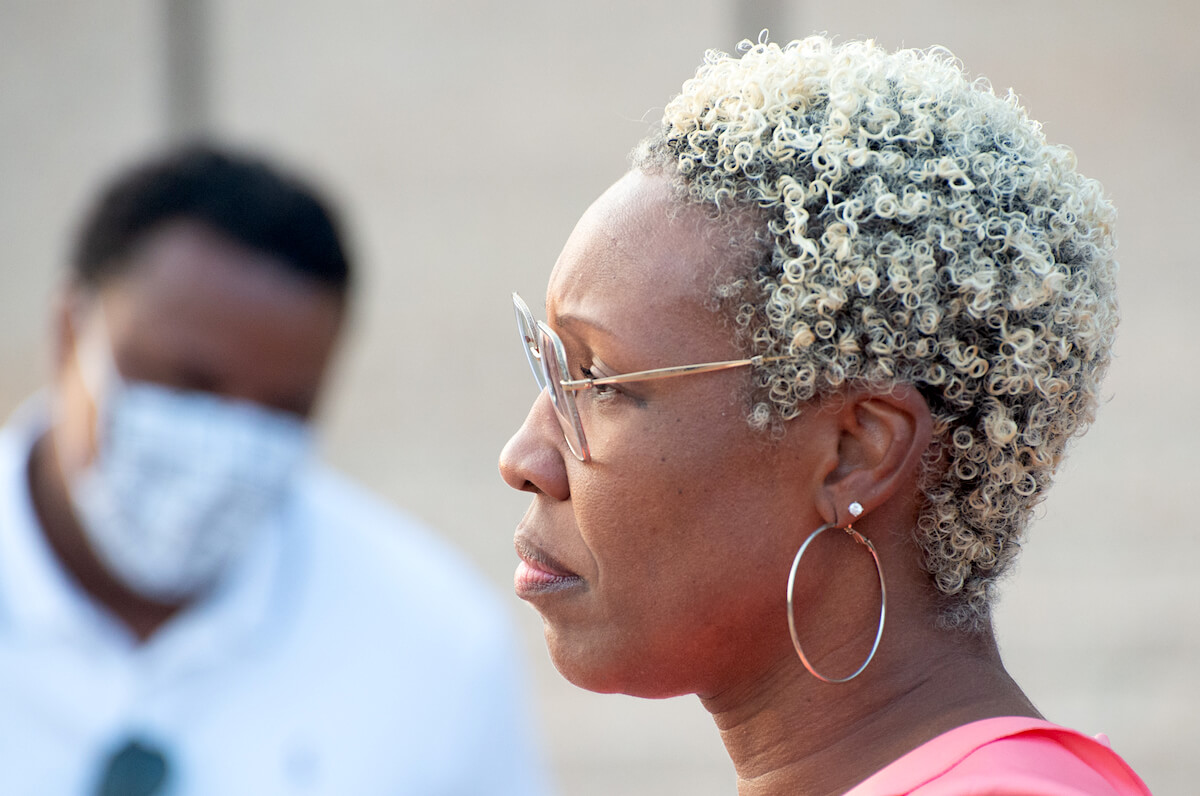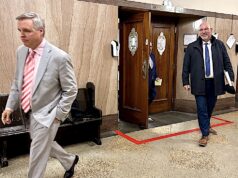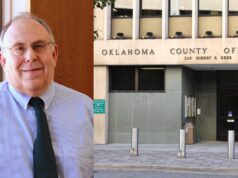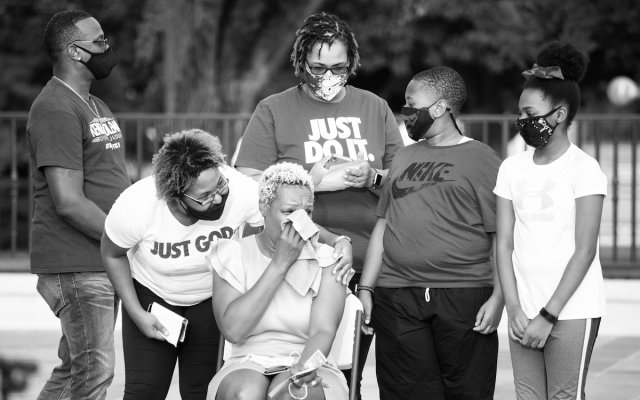
In watching and writing about Kendra Coleman’s struggle to retain her seat on the Oklahoma County District Court bench, it struck me how her life had been exposed to the public in a way few of us will ever endure.
After a three-week trial before eight fellow judges and a lawyer serving as jury, Coleman was removed from her position of state district court judge Sept. 18 by the Court on the Judiciary for misconduct in office.
Regardless of whether she was right or wrong, whether she deserved removal or whether the charges against her were racially motivated in what is clearly a troubled Oklahoma County Courthouse, the trial laid bare much of Kendra Coleman’s private life for observers to peruse like patrons at a Saturday morning yard sale.
Coleman was on trial in a rare proceeding live-streamed on the internet beginning every morning at 8:30 a.m. There were no commercials.
Had we not seen this trial, we would not have known much about this first-term judge who had ousted an incumbent during the 2018 election. How would we know about Kendra Coleman, the church girl? About the child of a preacher whose breakfasts and lunches were at the chapel? About the prize student of Star Spencer High School? Or the homesick college kid on a far away campus waiting for her father to come get her?
And then, after clawing her way through college and law school and finding success at a law practice in a little office on 23rd Street, Coleman’s ambition drew her to run for public office, to seek a district judge seat held by an incumbent, no less.
Perhaps the fuel for her ambition was her unwavering commitment to her community. And to her honesty. A former state Supreme Court justice ultimately testified she was incapable of duplicity.
“She is an open and honest person, and what you see is what you get,” said Dan Boudreau, the former justice commissioned by the Supreme Court to mentor Coleman after the court had reprimanded her for misconduct in December.
Boudreau’s observation may be true. But behind her smile — a trademark recognized by even those who stood witness against her — was a hidden life of financial trouble.
Beneath her apparent success as an attorney — and shielded by an expensive car and $500 shoes — sat a tax debt that surpassed the six-figure mark. To be precise, Coleman owed $100,683 in federal taxes and $17, 616.39 in state taxes, as well as a lesser amount for business property taxes owed to Oklahoma County. Despite this, she ran for the job of district judge, with an annual salary of $134,756, and won.
On the way, she had innocently accepted the help of fellow lawyers captivated by her personality and her drive and the groundswell of support in “her community,” a predominantly Black population of northeast Oklahoma County that includes her hometown, Spencer.
At the time, she did not know a campaign fundraiser would later lead to a jarring threat from one of the most powerful men in the community, a district attorney whose influence at the county courthouse would begin a cascade of legal problems for the first-term judge.
Money, it’s a gas
Before all that — and before George Floyd died at the knee of a policeman and the protests of Black Lives Matter saw Oklahoma City officers fire tear gas up Shartel Avenue — Kendra Coleman became in 2019 the only black district court judge assigned to felony criminal cases in metropolitan Oklahoma City.
That was an important event, given that the Black community comprised 10 percent of the population but accounted for nearly half the arrests and incarcerations. Coleman had said during her campaign she was going to be the judge to represent “her community.”
Coleman would bring a different perspective, but her role in looking for racial injustice from the bench would end in September 2019 when presiding judge Tom Prince transferred her from that criminal docket amid pressure from District Attorney David Prater.
Prater demanded she remove herself from all criminal cases (what became known as a “blanket recusal,” for which there is little legal precedent and no clear legal authority) when her evidentiary rulings hampered prosecutors from presenting gruesome crime scene photographs in a manslaughter trial over the horrendous pit bull attack of an elderly woman.
Prater found that one of Coleman’s campaign ethics reports which would have revealed campaign contributions from defense counsel had not been filed. It was eight months late.
Many lawyers contribute to judges’ campaigns and often combine to provide the majority of financing for judicial races. It does not tend to get favors from the bench, although it can look bad to the public. Coleman later said she knew the defense lawyer representing the pit bull owner had hosted the fundraiser, but she said she did not know what if any dollar contribution he had made. The prosecutors said it was $500, but testimony later showed it turned out to be $1,000.
A witness during Coleman’s removal trial said she quipped at the time: “I have shoes worth more than $500.” While Coleman’s words no doubt were intended to illustrate how she would not be biased over a $500 contribution, the comment would later become significant when evidence of her large tax debt surfaced.
How could a judge be so cavalier about her finances? And what potential leverage could bad actors gain over a judge who owes more than $118,000?
Coarse courthouse environment
Coleman’s removal trial also revealed disturbing conduct by other judges at the Oklahoma County Courthouse, some of whom previously served as assistants in the district attorney’s office.
District Judge Aletia Timmons, the only other Black district court judge in Oklahoma County (there are three Black special judges), testified that other judges had spread false and “racist” gossip about Coleman. Her testimony was a bombshell of dirty laundry shared to the public.
But the picture of a coarse environment among the judges had already been painted before Timmons testified.
District Judge Cindy Truong testified a court clerk employee had entered Coleman’s private chambers and photographed her draft response to Prater’s recusal motion — a response that was never publicly filed — and texted it to Truong’s cell phone without Coleman’s knowledge.
Instead of doing the honorable thing and advising Coleman of this breach of trust, Truong instead texted the document to Prater, who had been Truong’ s boss in the DA’s office before she was elected judge. Prater blindsided Coleman with the document in a recusal hearing. Until then, Coleman said, she was unaware her writing had been taken from her desk.
Prater made the dubious argument that the draft response was what he called “direct evidence” of Coleman’s unethical behavior of pre-judging his motion to recuse before the hearing. Prater, in fact, had already had two in-chambers hearing on the matter.
Pre-judging or not, had Coleman not gathered and written down her own thoughts and legal research on Prater’s unprecedented request for “blanket” recusal she would have been the victim of her own negligence. Prater had threatened to criminally prosecute her.
Surely the trial jurors of the Court on the Judiciary — eight of whom were judges — were stunned when Prater attempted to justify his actions. Certainly all of them had at some point prepared their own notes and memoranda of legal research upon receiving a motion and in advance of a hearing.
If Prater was justified in using so-called evidence lifted by a court employee from the judge’s chambers, what precedent would that set in their own courthouses if a district attorney came after them seeking recusal?
Defense lawyer Joe White attacked Prater for his role in what White suggested was a racially-motivated campaign to get rid of Coleman and which he said led to an unfair and biased investigation by the state Council on Judicial Complaints.
But Prater was not on trial. And judges, even those on a jury, tend to focus on the legal issues in front of them.
The legal issues here regarded Coleman’s actions, which included her failure to timely file a state campaign ethics report, her failure to pay her taxes and her apparent failure to treat all litigants and lawyers respectfully in her courtroom (conduct which the Council on Judicial Complaints said constituted “oppression in office.”)
There was also evidence questioning the propriety of expenses for cosmetics and a spa during Coleman’s election campaign. She said those were not personal expenditures but rather legitimate expenditures for campaign photographs and appearances.
Then there was the problem with her receiving cash campaign contributions greater than $50. Coleman converted those cash payments to money orders so there would be a record of it.
If Coleman was honest to a fault, in this instance that honesty was proof she had taken cash campaign contributions and violated the law prohibiting it.
A limit to attitude latitude
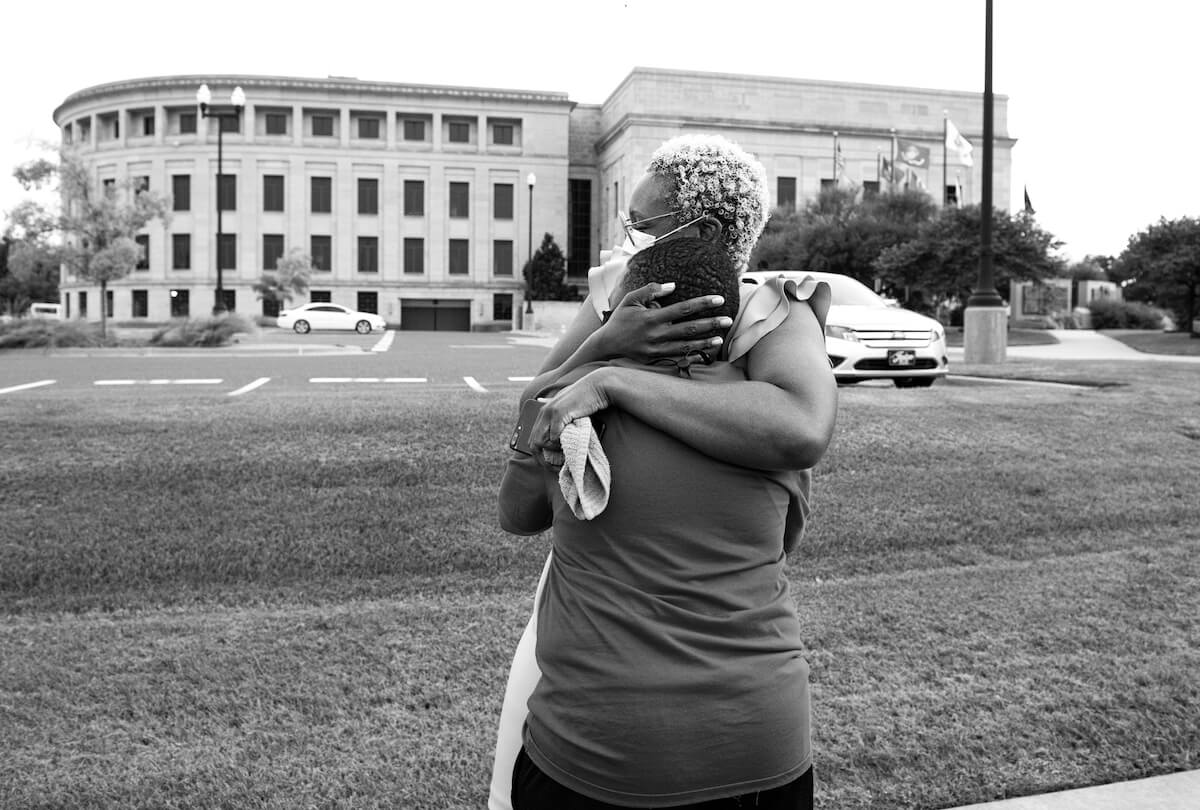
Much of the trial was consumed by witnesses who said Coleman mistreated domestic violence victims and their advocates appearing on the victim protection order (VPO) docket. Other witnesses said she did not.
The court also heard testimony that some lawyers were belligerent toward her, and Prater’s in-chambers hearing on his motion for recusal painted a tense picture. The audio recording of the hearing was played during the removal trial. In it, Prater accused Coleman of violating state ethics laws in a tone of voice that sounded like a school principal scolding a child who had misbehaved.
Frankly, I had never heard a lawyer speak to a district judge that way in my 35 years practicing law. Maybe judges will tell me otherwise, and perhaps it happens more often in the gruffer criminal court arena (in which I do not practice). But the entire conversation was shocking.
In the recordings, Coleman sounded polite at first. But then she turned to berate an assistant district attorney in attendance, asking him “Why are you here?” and then ordering him not to speak.
In fairness, it is a common rule of judges that only one lawyer may argue for a client at a hearing, and so it is possible Coleman believed the prosecutors were teaming up against her. Perhaps a feeling that her worthiness of being a judge was being challenged explains some of Coleman’s later behavior from the bench that prosecution witnesses described as being abusive.
I interpreted that testimony as describing a judge believing she had to assert herself to prove to all she was the judge. One court bailiff painted a picture of a courtroom full of disrespectful lawyers and a judge repeatedly having to establish her authority.
Doing so, Coleman sometimes went overboard. There was evidence she had allegedly violated the constitutional rights of visitors held in contempt for being disruptive in her courtroom. She had not scheduled hearings for them to explain their actions and be represented by a lawyer before placing them in jail. But there was also testimony that other judges had previously done the same.
Some of the controversial incidents involving Coleman appeared to be mistakes made by a judge lacking the experience and training needed to avoid the traps and pitfalls a newly elected young judge might encounter.
In the past, new judges were trained at the National Judicial College in Reno, Nevada. But that training became a victim of budget cuts to the state court system long ago. Other than a brief orientation, newly elected Oklahoma judges now hit the ground running, no matter whether they know on what path their courtroom journey will lead.
Taken individually, each incident of Coleman’s questionable conduct from the bench was not enough to remove her from office, and acting prosecutor Tracy Schumacher offered no “smoking gun” evidence. But, as one observer noted, Coleman’s demise became “death by a thousand cuts”. The collective weight of the case against Coleman grew with each new allegation and complaint Schumacher added to the pile.
A dissenting juror/judge later wrote that Coleman’s defense had countered every allegation of abusive behavior with conflicting testimony and that the prosecution had failed to prove its case by its burden of clear and convincing evidence.
But one thing I’ve learned defending clients is that the more one has to explain away, the more difficult it is to win. Or, as my chemistry teacher father would have said, the Coleman removal trial became an exercise in quantitative analysis rather than qualitative analysis.
Tax troubles tipped the scales
In the end, there was one item of evidence that may have tipped the scales of justice against Coleman.
And it had been there all along — before she even ran for office. It was how much she owed in taxes.
Coleman faces trial in November on a felony charge of state income tax evasion brought by Prater. Her guilt or innocence of the criminal charge was not decided by the removal trial jury, but the existence of her enormous outstanding tax debt was considered in determining whether she was fit to remain in office.
RELATED
Read previous coverage of the Kendra Coleman removal trial by Michael Duncan
To address that, Coleman’s lawyers presented testimony that she had indeed filed her tax returns, one being late but eventually filed. And, most importantly, she had entered into an agreed payment plan with the Oklahoma Tax Commission.
Still, owing all that money in taxes surely caused the jurors pause. Schumacher especially understood it was an issue that would be significant to this particular jury. Having been a district judge herself in Cleveland County for six years, Schumacher knew what would resonate with eight other district judges. For decades, significant tax liability has been a disqualifier for candidates seeking appointment to judicial positions.
Coleman was elected to her position as judge, but her vacancy will be filled by an appointment from the governor from a list of three persons recommended by the Judicial Nominating Commission. The JNC will take applications and conduct background checks, including whether any applicant has tax debt. The JNC has shown it will not forward a name to the governor of an applicant with significant tax issues, such as Coleman had.
There is good reason for avoiding judges with tax problems. If a judge is financially compromised, it could affect their objectivity on the job and increase their chance of being unduly influenced by actors instead of the law. Also, if a judge cannot maintain their own personal financial affairs, how can they be expected to make good decisions that impact the wellbeing of litigants in their courtroom?
And so the jury in Coleman’s removal trial may have been faced with that question: Was it good to keep this judge in office when, under other circumstances, another person in similar tax trouble would be disqualified from appointment?
I have learned trying jury trials that it can be a bit foolish to predict what juries will do and why. They are often unpredictable, and that is true even when the juries are comprised of judges, such as in this case.
But I also know that sometimes one item — one bit of evidence to which the jury can relate — can nudge one or two jurors off the fence and provide the necessary votes to reach a verdict.
Taken with all the other bits of evidence, Coleman’s tax problems — a personal issue that became public in this trial — may well have been that one item which this jury found significant enough to decide she should be removed from office.
The Coleman verdict was 5-4 for removal. A majority vote was all that was needed. Six jurors found she had violated the Judicial Code of Conduct and committed oppression in office. However, the judgment stated she would not be disqualified from future judicial office.
Coleman and her attorneys have to decide this week whether she will file a notice of appeal in the removal verdict.
Vigil a calm before the verdict
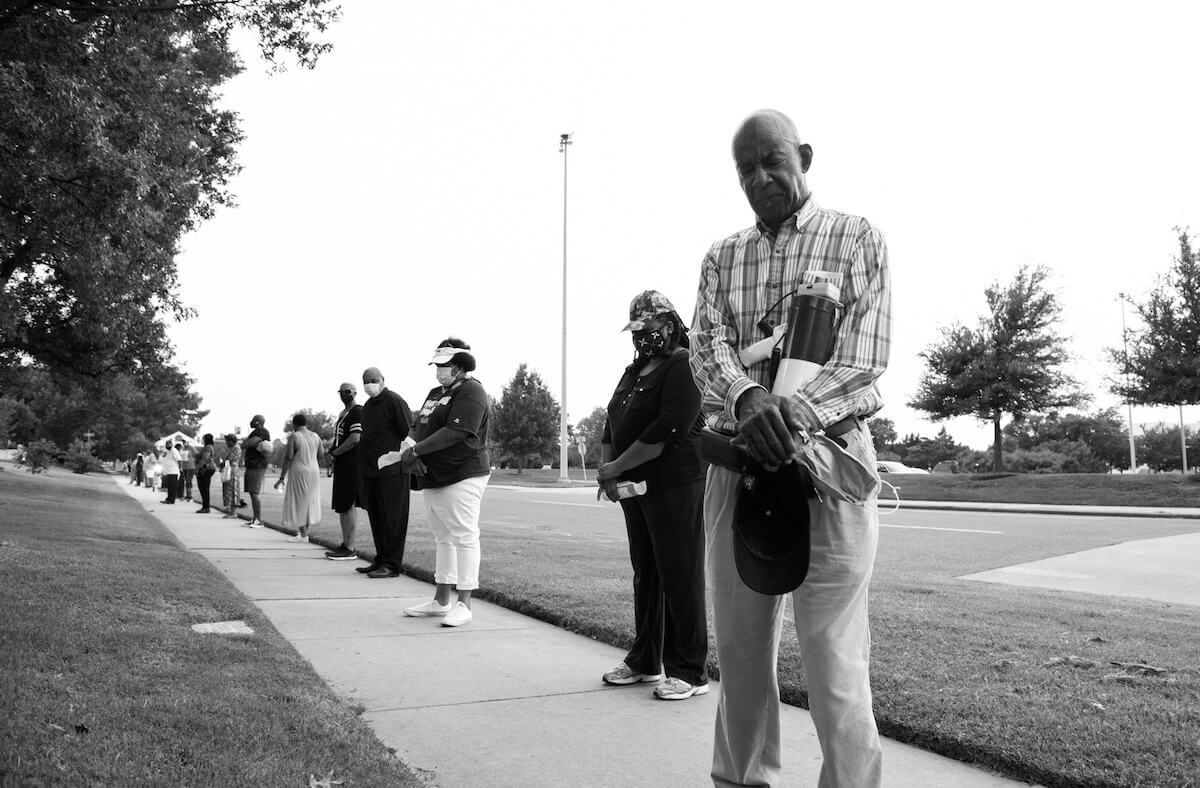
On the eve of the Coleman trial’s closing arguments, about 180 supporters of Coleman gathered with her outside the Supreme Court building where her trial was conducted in a prayer vigil and rally.
Court officials were initially worried the rally might turn violent or that the judges would be inappropriately confronted when leaving the building. The rally organizers agreed to wait until 7 p.m. when all the judge-jurors were gone for the day.
There was no violence or confrontation. There were ministers leading prayer, gospel singers singing and parishioners, many from Coleman’s own church, showing their good wishes for Coleman. This was no visible display of anger. It was a show of support for one of their own.
Many said they believed that Prater’s conduct and the ugliness that had been revealed during this trial was emblematic of unfairness and racism, despite the litany of complaints, reprimands and suspensions Coleman had received. Few in attendance believed those complaints about Coleman would have come so far were race not a factor, but the focus of the rally and vigil was to tell Coleman they were there for her.
The group formed a human circle around the court building and prayed for the Court on the Judiciary to treat her fairly.
Coleman’s life had been displayed to strangers watching on the internet for three weeks. But those in attendance at the vigil already knew everything they needed to know about her.
Coleman was overcome by the showing. Her tears and the hugs of well wishers stood out for me as evidence that no matter what the verdict would be the following day, she would endure because they had her back.
For this community, no matter the outcome of this trial, Kendra Coleman was their church girl from Spencer, and nothing was going to change that.










